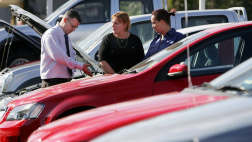If you feel there’s already a mind-blowing number of choices in the new-vehicle market, here’s more things to ponder.
What engine do you pick? What fuel is best, and do I save money in the long run by opting for an economical diesel?
We put one popular SUV - with three engine options - to the test with a result that will really surprise you. It certainly surprised us!
Prices:
Drive long distances or live in regional Australia and you’ll naturally think of a diesel vehicle for long range and good fuel economy.
For a sporty drive, you may think of a turbocharged engine or for commuting or general suburban running with a few country trips thrown in, maybe the basic petrol engine saves money with its cheaper purchase price?
It’s a running-cost quandary that we’re happy to help answer, but before you decide, know that the result may or may not be cut-and-dried.
Here’s our look at one of Australia’s most popular SUVs - the Mazda CX-5 - in its three engine options of diesel, petrol and turbo-petrol. Mazda doesn’t offer the CX-5 with a hybrid - yet.

For simplicity, we’ve chosen the top-spec Akera version that comes with the three engine options.
This version is fully specified, all-wheel drive and - while not amongst the cheapest of the popular SUVs - a premium choice that has everything a family will want in terms of comfort, convenience and safety.
Best of all, the three engine options have their own character, advantages and disadvantages, yet when it comes to purchase price, surprisingly are separated only by a mere $3000.
Petrol - $49,380 (plus on-road costs)
The basic 2.5-litre naturally aspirated petrol engine is the same basic powerplant as the turbo-petrol, but naturally the sizzle is muted. It attracts the buyer wanting a well-kitted-out SUV with loads of features yet without the necessity of a power kick.
This four-cylinder is already available in other Mazda models such as the Mazda6 and Mazda3, so it’s well proven and a popular buyer choice, especially over the entry-level and rather lacklustre 2.0-litre that is available in other CX-5 variants but not in the Akera.
This 2.5-litre unit delivers 140kW/252Nm (so down 30kW/168Nm on the turbo), which is satisfying enough for most city and country duties. The outputs show the advantage of a turbo, but the fuel consumption shows the advantage of the lower-tech engine, with a commendable 7.4L/100km claimed average. In our real-world testing, it’s 8.8L/100km.
Turbo-petrol - $51,880 (plus on-road costs)
This is the performance version with the 2.5-litre turbo-petrol engine transferring from selected versions of the Mazda6 car to the CX-5 SUV to bring a bit of zing.
The four-cylinder - which is also fitted to the seven-seat CX-9 and replaces a rather thirsty petrol V6 - whacks out 170kW/420Nm, which is pretty close to the meaty output of the diesel. It also gives the CX-5 a sparkle that is uncharacteristic for a mid-size SUV, with a 0-100km/h acceleration time of a brisk 7.7 seconds.
But what goes up must eventually come down, and Mazda claims the turbo-petrol drinks at the claimed rate of 8.2L/100km and, in real-world testing, 9.2L/100km.
Diesel - $52,380 (plus on-road costs)
Like the other engines, Mazda spreads the diesel’s love across other models, and it’s been around for a few years and has a strong record for durability.
This is ostensibly aimed at buyers doing long distances, so fuel tank range is as important as the low fuel consumption. This is especially important for country running, as it stretches the distances between refuelling and makes up some of the cost of higher regional fuel prices.
The 2.2-litre twin-turbo four-cylinder engine delivers 140kW/450Nm (down 30kW of power but up 30Nm of torque over the turbo-petrol) and is a great balance for a variety of driving conditions.
It’s biggest advantage, at least on paper, is the measly 5.7L/100km claimed consumption. That gives the diesel a range from its 58L tank (common to all CX-5s) of 1018km. Real-world usage is 6.4L/100km.
Running costs:
.jpg)
With only $3000 separating these, purchase price isn’t a big deal. What should be considered is how much these different versions are going to cost over our three-year test period.
What are they like on fuel, how much do they cost to service and what else needs to be considered if you’re after the best pick, or if you simply want to know how much and how regularly you’ll be emptying your wallet to keep it on the road.
For reference, Mazda Australia offers a five-year/unlimited-km warranty and a five-year roadside assistance program.
Turbo-petrol
Based on our average of 12,000km a year and a $1.30/L petrol price, the turbo-petrol will cost $1279 a year to fuel ($3837 for three years).
Fortunately, Mazda has tuned this to run on 91RON unleaded, which is rare for a turbo-petrol engine. Usually, these things are geared to exclusively drink more expensive 95RON or even 98RON.
Mazda has a capped-price service program but insists on service intervals of 10,000km, shorter than most peers that are generally 15,000km. That either means you service more regularly - and expensively - or ease back on your annual travel distance.
Based on the 10,000km schedule, Mazda will charge $1077 for the first three years (three services), but there will be some additions including fluid replacement which adds a few more dollars to the bill.
In total, the turbo-petrol’s fuel and servicing costs come to $4914 for three years.
Petrol
The petrol is more fuel efficient than the turbo-petrol and, over the same annual distances, will cost $1154 - a saving of $125 a year - or $3462 for three years.
It has a less complicated engine and is less expensive to service, with the three-year bill coming in at $1041, for a total fuel and servicing cost of $4503 over three years.
Diesel
A diesel will save you substantial bucks if you do a lot of miles or even if you spend time in traffic, where it is a more gentle drinker.
Based on Mazda’s 5.7L/100km claim, the diesel CX-5 will cost $958 a year or $2873 over three years, based on a fuel cost of $1.40/L.
The servicing is a bit more expensive. The three years of capped-price servicing for the diesel is $1119 (plus fluids and filters). All up, the fuel and servicing costs come to $3992 for three years.
So ,the cheapest version to own over three years is the diesel.
But to buy the diesel version will cost $500 more than the turbo-petrol and $3000 more than the petrol.
Result
.jpg)
Surprisingly, there’s not a lot in it.
If you compare the turbo-petrol and diesel, the latter is cheaper to own over three years by $922.
Factor in the purchase price, and the diesel may cost an extra $500 but its buyers are still in front by $422 after three years.
If you really wanted to make savings, then the petrol is the less expensive to buy and pretty light on in ownership.
It’s about $500 more expensive to own over three years than the diesel but costs $3000 less to buy, so you’re $2500 in front.
That $2500 saving alone will give the petrol owner in ‘free’ fuel for a bit over two years.
Pick the diesel and you’ll have a classy country cruiser that will mix it up in the city, keep you away from the fuel bowser for more than 1000km and be equally as economical in its normal servicing period.
As for the turbo-petrol, that’s simply a lot of fun to own and drive. And you don’t have to pay too much more to have that.


.jpg)
.jpg)







.jpg)

.jpg)



.jpg)


.jpg)
.jpg)
.jpg)

.jpg)
.jpg)
.jpg)


.jpg)

Comments